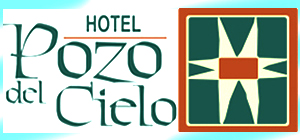PERU TOUR PACKAGES
- 4x4 Rental & Tours In Peru
- Private Ground Transportations In Peru
- DAY TRIP FROM CUSCO TO PUNO with stop at NEW Pallay Punchu Rainbow Mountain
- 2 DAYS PRIVATE SHUTTLE FROM CUZCO TO PUNO THOUGH MOUNTAINS
- Peru Self Driving Cars
- 4WD Exclusive Private Transfer From Arequipa To Puno
- Day Tour To Reserva De Salinas Y Aguada Blanca
- One Day Arequipa Off-Roading Tour
- Half Day Sandboarding Tour In Arequipa
- 3 Day Of Adventure Tours In Arequipa
- Full Day Sandboard Tour From Lima
- Lima Paracas Ballestas Ica Wineyards Huacachina Nazca Llines In 2 Days
- 6 DAYS COLCA CANYON ADVENTURE TOUR Rock Climbing - Biking - Horse Riding - Hiking & Camping
- Cusco Traditional Tour And Inti Raymi Festival
- Lima Cusco And Machu Picchu 3 Days
- Cusco Sacred Valley And 2 Days Inca Trail Trek To Machu Picchu
- Tour To Amazon Rainforest And Machu Picchu In 6 Days
- Cusco And Classic 4 Days Inca Trail Trek To Machu Picchu In 7 Days
- Jungle Tour - White Water Rafting And Lares Trek To Machupicchu - 14 Days
- Lima Amazon Jungle Cuzco And Machu Picchu Tour - 7 Days
- Tours to Nazca From Lima 2 Days
- Full Day Flight Nazca Lines From/to Pisco
- Lima Paracas Nasca Tour 3 Days
- Lima Cusco And Arequipa Tour 8 Days
- Full Day Nasca Lines By Luxury Public Bus
- Overflight Nazca Line From Lima By Aircraft Travel - Full Day Guided Tours
- Nasca Line From Lima By Land & Aircraft Travel - Full Day Guided Tours
- Daily Flights Over The Nazca Lines From Ica - Half Day Tour
- Sandboard And Sand Buggy In Peru 5 Days
- NEW Sandboarding Tour In Arequipa - Full Day Guided Excursion
- Cusco Complete Tour 5 Days
- Cusco And Puno Tour 7 Days
- Cuzco Colca Canyon Arequipa - 4WD Guided Tour 2 Days
- NEW 4X4 Expedition From Cuzco To Colca Valley And Arequipa 3 Days
- NEW Arequipa Colca Canyon Puno Guided Tour In 2 Days
- Arequipa And Puno Tour 6 Days
- 4x4 Tour Arequipa - Colca Canyon - Cusco 3 Days
- NEW Puno Colca Canyon Arequipa Guided Tour In 2 Days
- Peru Classic Tour 14 Days
- Peru Classic Tour And Inka Trail To Machu Picchu 14 Days
- Peru Luxury Tours 7 Days
- Peru Adventure Tour 24 Days
- Peru Jungle Tour
- Peru Bike Tours 14 Days
- Peru Mountain Biking 25 Days
- Peru Mountain Climbing
- Peru Off Road Tour
- Peru Royal Tour 8 Days
- Peru Trekking 25 Days
- Peru South Coast Tour 7 Days
- Peru Motorcycle Tour 21 Days
- Puno Colca Canyon And Arequipa Tour 3 Days
- Puno Colca Canyon Puno 2 Days
- Puno Colca Canyon Puno 3 Days
PERU ECOLOGICAL AND CULTURAL LECTURE
Flora
La Tuna
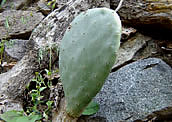 This cactus is also abundant all the year, in the andean valleys also in dry areas (from sea level up to 3700m). The fruit come in a varieties or at different stages of maturaty but the colour depends on where the cactus growe and the types of minerals in the soil. The most commom colour is yellow, The leaf of the cuctus is also used as a laxative for people in the high valleys. Tuna cactus have small animals (parasite) named COCHINILLA, in 90s the local people started to infected the Tuna plans with these pigmments, at the present time they sell it to the exporting company to produce painting for nails and lips. in time of the Incas they used it combining with different mineral and vegetal oxides, thus obtained much variety of colors, that painted their instruments of wars, textiles, ceramics, their faces in special ceremonies and many other daily representations that until today we can appreciate in the museums.
This cactus is also abundant all the year, in the andean valleys also in dry areas (from sea level up to 3700m). The fruit come in a varieties or at different stages of maturaty but the colour depends on where the cactus growe and the types of minerals in the soil. The most commom colour is yellow, The leaf of the cuctus is also used as a laxative for people in the high valleys. Tuna cactus have small animals (parasite) named COCHINILLA, in 90s the local people started to infected the Tuna plans with these pigmments, at the present time they sell it to the exporting company to produce painting for nails and lips. in time of the Incas they used it combining with different mineral and vegetal oxides, thus obtained much variety of colors, that painted their instruments of wars, textiles, ceramics, their faces in special ceremonies and many other daily representations that until today we can appreciate in the museums.
El Mague
>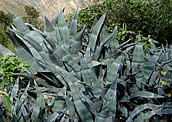 This cactus is abundant in the Andes(3000 - 3800m) and is widly used by the people for a variety of thing. The insides of the cactus can be stripped and the fibers on the inside can be used t make rope. The Mague flowers once a year and the stem of the flower when dried is hollow and very strong, in some places the people used it for the rafters in the houses and frame work generally. The Mague has yellow and orange flowersand just one time per year.
This cactus is abundant in the Andes(3000 - 3800m) and is widly used by the people for a variety of thing. The insides of the cactus can be stripped and the fibers on the inside can be used t make rope. The Mague flowers once a year and the stem of the flower when dried is hollow and very strong, in some places the people used it for the rafters in the houses and frame work generally. The Mague has yellow and orange flowersand just one time per year.
El Molle
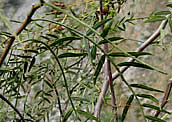 This is medicinal tree, the fresh green leaf are used for an insect repelliant. The juice between the leaf and the stem is used for cuts and has a fast healing agent. The seeds are red colour (peper size) some communities used to do sweet and very tasty drink in special festivities. The Molle is very common tree to make firewood and grows in coast untill the half Andes.
This is medicinal tree, the fresh green leaf are used for an insect repelliant. The juice between the leaf and the stem is used for cuts and has a fast healing agent. The seeds are red colour (peper size) some communities used to do sweet and very tasty drink in special festivities. The Molle is very common tree to make firewood and grows in coast untill the half Andes.
La Jatipa
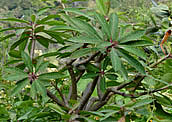 Is tipycal plant of green season (Dec - March) in andean valleys (2000 - 3000m). It has a milk inside the stark which is milky to llok apun but is quite asidic. It is not dangerouseon yhe skin but in the eye it is potentially harmul. This plant produce orange flowers after the rain season and the rest of the year is completly dry, some times is possible to apreciate huge jungle of flowers on the slops of the mountains.
Is tipycal plant of green season (Dec - March) in andean valleys (2000 - 3000m). It has a milk inside the stark which is milky to llok apun but is quite asidic. It is not dangerouseon yhe skin but in the eye it is potentially harmul. This plant produce orange flowers after the rain season and the rest of the year is completly dry, some times is possible to apreciate huge jungle of flowers on the slops of the mountains.
Los Cojones Del Diablo
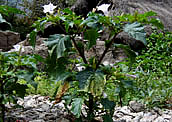 The name of this plant means "balls of the devil", adiquitly named this plant has a small fruit that is green and spikly, it is used within the area of medican by the most knowledgeable in the andes and has hulisingenic qualities. When not used correctly it can be potentially dangerous. This plant are in the reany season only and has white flowers.
The name of this plant means "balls of the devil", adiquitly named this plant has a small fruit that is green and spikly, it is used within the area of medican by the most knowledgeable in the andes and has hulisingenic qualities. When not used correctly it can be potentially dangerous. This plant are in the reany season only and has white flowers.
El Rupo
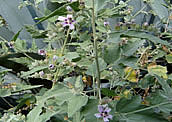 An other small plant of the rain season, has purple flowers, grown between sea level up to 3000m. With a deliciouse small when rubbed between fingers. Used for infusions.
An other small plant of the rain season, has purple flowers, grown between sea level up to 3000m. With a deliciouse small when rubbed between fingers. Used for infusions.
La Jaccana
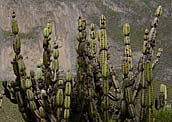 One of the many kind of cactus grows between the coast and tha half Andes of Peru, Bolivia, Chile, Argentina, Ecuador and Colombia. Has a sweet fruit, similar to the Tuna fruit, the product is one time per year after every rain season, is a big cactus (6 meter high) favorite cuctus for the small birds to make nest.
One of the many kind of cactus grows between the coast and tha half Andes of Peru, Bolivia, Chile, Argentina, Ecuador and Colombia. Has a sweet fruit, similar to the Tuna fruit, the product is one time per year after every rain season, is a big cactus (6 meter high) favorite cuctus for the small birds to make nest.
Pita
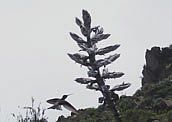 Small cactus grows at the half of the Andes (2000 - 3200m), has purple flowers once a year similar to the Mague. A favorite with Humming birds.
Small cactus grows at the half of the Andes (2000 - 3200m), has purple flowers once a year similar to the Mague. A favorite with Humming birds.CONTACT US
For more information about the tour or you request a new date to departure for this tour, please contact us.... Some of our clients e-mail us saying our confirmation e-mails are placed to their spam folder rather than their inbox. We recommend to modify your JUNK or SPAM FILTER SETTINGS to receive our e-mail peruadventurestours@hotmail.com on the correct inbox. You may also want to add this email address to your list of known contacts. This will prevent our responses from being filtered into your Junk or Spam mail folder.
References Of Travel Guide Books To Peru
ADDITIONAL BOOKING SERVICES
- Camping Zone In Arequipa
- Bus Tickets All Over Peru
- Guided Tour Bus From Cusco To Puno
- Bus Transfer From Arequipa To Puno
- Bus Transfer From Colca Canyon To Puno
- Bus Transfer From Puno To Arequipa
- Airplane Tickets In Peru
- Railway Tickets In Peru
- Learn Spanish In Peru
- Rent A Car In Peru
- Rental Camping Gear In Peru
- Work In Peru
- Donation Program
PERU TRAVEL INFORMATION
- Embassies And Consulates In Peru
- Information Of South American Camelids
- Tips To Travel Around Peru
- Peru Adventure Magazine
- History Of The Incas And Tawantinsuyo Territory
- Inti Raymi Celebration In Cusco - The Festival Of The Sun God
- Travel Insurance To Peru
- Peruvian Government Taxes
- Travel Agent
PERUVIAN GASTRONOMY INFORMATION
- Peruvian Food
- History Of The Peruvian Cuisine
- Inca Cuisine
- Cuisine Of The Central Coast Of Peru
- Cuisine Of The Northen Coast Of Peru
- Cuisine Of The Andes Of Peru
- Cuisine Of Peruvian Jungle
- Art Culinary Of Arequipa
- Desserts And Sweets Dishes Of Peru
- Peruvian Recipes
- Peru Gastronomic Festivals
- Cultivation Of Ancient Plants Of Peru
- Coca Leaf






